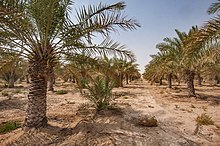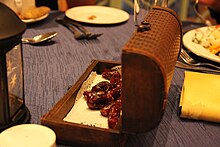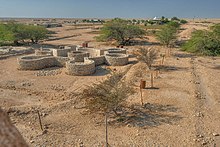
Agriculture in Qatar Till quite recently, it was thought that Qatar's environment was not at all favorable for plantation and organic farming due to its harsh temperature during the summer months, desalinated chlorine water, poor annual rainfall and arid soil that all add up to quite the challenge of turning a desert area into a green oasis is inherently limited in scope due to the harsh climate and lack of arable land.[1] In spite of this, small-scale farming, nomadic herding, pearling, and fishing were the predominant means of subsistence in the region until the commencement of oil drilling in 1939.[2]
Although the relative importance of these activities has declined as a means of livelihood (with commercial pearling disappearing completely), the government has attempted to encourage agriculture and fishing to provide a degree of self-sufficiency in food.[2]
History[edit]
Date palms were one of the earliest crops to be cultivated in the peninsula.[3] Beginning in the Bronze Age, the trading of date palms had a significant impact on the Qatari economy.[4] Date palm leaves were also commonly used as a construction material.[5] However, as Qatar's geography and climate was unsuitable for large-scale crop cultivation, the bartering of date palms had a lesser impact on Qatar's revenues than did pearling. As the waters surrounding Qatar contain some of the most abundant pearling beds in the world, this was the main source of income for Qatar's inhabitants until the discovery of oil in the 20th century. Pearl trading was supplemented in some areas by camel breeding. Fishing also played an important role in the economy.[6]
J.G. Lorimer's wrote about the role of agriculture for settled villagers in 1908 in his Gazetteer of the Persian Gulf:[7]
"The principal and almost the exclusive source of livelihood in Qatar is pearl-fishing, supplemented in some places by the breeding of camels. Agriculture hardly exists. The only date palms-- and they are not numerous-- appear to be those in the gardens at Laqta, Markhiyah, Mushairib, Na'aijah, Sakkak, Sakhamah and Wakrah; and it is not clear that any vegetable gardens exist except at some of the same places, A few semi-wild clumps of dates are found on the west coast near Dohat-as-Salwa. Besides camels the settled villagers have a few horses and cattle, which they keep in their own possession, and some sheep and goats which are tended for them by the Bedouins. They also fish along the coast of the district.
These remarks are not intended to apply to the Bedouins of Qatar, who are pastoral in their habits, like the rest of their race elsewhere, and own livestock in the proportions usual among Arab nomads."

| City | Fishing boats | Camels | Horses |
|---|---|---|---|
| Khor Hassan | 5 | 20 | 0 |
| Abu Dhalouf | 10 | 30 | 0 |
| Ar Ru'ays | 10 | 20 | 4 |
| Fuwayrit | 12 | 100 | 20 |
| Al Thakhira | 5 | 10 | 0 |
| Al Khor | 30 | 100 | 0 |
| Simaisma | 10 | 70 | 6 |
| Al Daayen | 10 | 60 | 10 |
| Lusail | 3 | 70 | 20 |
| Doha | 90 | 800 | 150 |
| Al Wakrah | 30 | 150 | 40 |
After Qatar began reaping significant monetary returns from oil drilling in the 1950s to 1960s, the number of Qataris employed in agriculture witnessed a decline, as the country now had the means to import large amounts of food.[9]
When food prices started rising in the early 1970s, Qatar realized the importance of attaining food self-sufficiency. At the beginning of 1974, the emirate requested the Arab Organization for Agricultural Development to send researchers to study it and corroborate their results with those of an earlier UN report of the country's terrestrial and marine resources. After nearly half a year of study starting in July 1974, the research mission submitted its report to the government in November 1974. In September of that year, Qatar created a committee that would examine ways to help boost the country's agricultural development. A report released by Qatar's ministries, also in 1974, disclosed that agriculture only accounted for 0.65% of all contributions to Qatar's GDP.[9]
Cultivation and livestock[edit]


Only 2.5% (28,000 ha.) of the land in Qatar is arable or suitable for use as pastureland. This is a major increase from the two prior decades. In 1996, 8,312 ha. of land was arable, while in 1980 only 2,256 ha. was arable.[3]
Farming currently plays only a minor role in the economy. Of the 8,312 ha. of arable land in 1994, 2,345 ha. were used to cultivate permanent crops, while 5,987 ha. were used to grow annual crops. Date palms were the most abundant permanent crop.[3] Root vegetables such as carrots, potatoes, onions and fodder beets are also some of the most important crops produced by Qatari farms.[10]
Between 1960 and 1970 agriculture grew.[2] The number of farms, for example, increased fourfold to 411.[2] Qataris who own agricultural land or properties generally hold government jobs and hire Pakistanis, or non-Qatari Arabs to manage their farms.[2] The government operates one experimental farm.[2] Of land under cultivation in 1990, about 48 percent was used for vegetables (23,000 tons produced), 33 percent for fruit and date production (8,000 tons), 11 percent for fodder (70,000 tons), and 8 percent for grains (3,000 tons).[2] In 1990 the country had approximately 128,000 head of sheep, 78,000 goats, 24,000 camels, 10,000 cattle, and 1,000 horses.[2] There are also dairy farms and about 2,000 chickens for poultry.[2] All but 20 percent of local demand for eggs is met domestically.[2] Despite the encouragement of agriculture and fishing, these two elements of the economy together produced only about 1 percent of the gross domestic product in 1989.[2]
In July 2017, following the closure of Qatar's only land border with Saudi Arabia, the country announced plans to airlift 4,000 cows in a bid to meet around one-third of its dairy demand. Local company Baladna will be responsible for the dairy production.[11] Later, Baladna announced that it will be importing an additional 10,000 cows so that they can meet Qatar's dairy requirements in full by 2018.[12] Domestic production of meats, dairy products, and crops increased by 400% from June 2017, the onset of Qatar's diplomatic spat, to March 2018, according to the Ministry of Municipality and Environment. Nearly all (98%) the demand for poultry is being met.[13]
By 2019, Qatar's vegetable output increased by 20% since mid-2017 to 66,000 tonnes per year. It is expected to further increase by 20,000-40,000 tonnes by 2020. Prior to the embargo, Qatar produced only 20% and 10% of its dairy and poultry needs respectively. By 2019, the country became self-sufficient.[14]
Date syrup[edit]

The manufacturing of date syrup is one of the oldest industries in Qatar, dating back to at least the 17th century. Qatar's natural landscape can support only a few types of agriculture, and date palms are among them. The syrup was obtained by using a traditional date press called madabis or madbasa. Due to its high-calorie content and nutrient density, it was a cheap and quick source of energy for the locals, particularly pearl divers.[15]
The construction of madabis employed traditional techniques reflective of the era. Utilizing locally available materials such as stones, limestone, sandstone, and coral, craftsmen built these rectangular or square rooms with meticulous attention to detail. The outer walls, made of irregular stones, provided structural integrity, while inner walls crafted from beachrocks (faroush) added insulation. Traditional roofing methods, including danshal (mangrove) beams and palm fronds, ensured stability and protection from the elements. With a short harvesting season for dates, the production of date syrup allowed for their preservation and prolonged consumption. This syrup served both civil and commercial purposes, being traded as a commodity and providing sustenance during periods of tribal conflicts and unrest. While modernization and lifestyle changes initially led to a decline in date syrup consumption, recent trends toward health-conscious alternatives have sparked renewed interest in this traditional sweetener.[16]
Soils[edit]
Qatar's soils vary in soil texture, ranging from sandy loam to heavy calcareous clay. The majority of cultivation that occurs is on clay loam soil. However, there are numerous problems with this soil, including high salinity levels, low amounts of nutrients, and a bad water infiltration rate.[9] Most of the soils in Qatar are orthents, meaning they lack horizon development and are very shallow.[17]
Limitations[edit]

Severe conditions, such as extremely high temperatures and lack of water and fertile soil, hinder increased agricultural production.[2] Orthents, the predominant soil type in the peninsula, accounting for approximately 1,020,000 ha., are unfavorable for crop cultivation because of their extreme shallowness.[17] The limited groundwater that permits agriculture in some areas is being depleted so rapidly that saltwater is encroaching and making the soil inhospitable to all but the most salt-resistant crops.[2] The northern section of Qatar comprises the most significant source of fresh groundwater in the country, mainly due to the more advantageous hydro-geological conditions than those that exist in the southern section of the country.[18] The rate of groundwater extraction in 1966 was 20 million m3/year. This increased to 120 million m3/year by 2000. Studies have approximated that aquifer storage will be completely exhausted by 2025.[18]
Pearling[edit]
Pearling was the main source of revenue for Qatar until the discovery of oil in 1939.[19] Approximately 85 pearl beds exist in Qatar's territorial waters.[20] Pearling is an ancient practice in the Persian Gulf, though it is not known exactly when Arabs began diving for pearls. It has been suggested that the profession dates back to the Dilmun civilization in Bahrain 5,000 years ago, which the inhabitants of Qatar came into contact with at the time.[21] Historically, the season for pearl harvest was divided into 3 periods. Hansiyah lasted for 40 days and commenced in mid-April. Ghaus Al Kebir, the primary pearl diving season, took place from May to 10 September. Lastly, Ruddah occurred from late September to early October.[22] Sambuk, a type of dhow, was traditionally used for pearling trips. From the 18th to 20th centuries, the majority of pearls were exported to Mumbai where they would be classified and sent to European markets. The remaining yield would be sent to markets in Baghdad.[23]
The captain of a pearling craft is called noukhadha, and is responsible for the most important tasks of a pearling trip such as managing interpersonal conflicts between the divers (al-fawwas) and the storage of pearls in the pearling vessel, which is known as al-hairat. The al-muqaddim is responsible for all ship operations while the al-sakuni is the driver of the ship. Slave labor was occasionally used by pearling crews.[21]

| City | Number of boats | Number of men |
|---|---|---|
| Khor Hassan | 20 | 240 |
| Abu Dhalouf | 20 | 200 |
| Ar Ru'ays | 18 | 270 |
| Fuwayrit | 35 | 420 |
| Al Thakhira | 15 | 180 |
| Al Khor | 80 | 1200 |
| Simaisma | 50 | 600 |
| Al Daayen | 70 | 840 |
| Lusail | 9 | 90 |
| Doha | 350 | 6300 |
| Al Wakrah | 150 | 2550 |
Zubarah, a settlement on the northwest coast of Qatar, is one of the best preserved and most extensive pearling settlements in the region.[24] Reaching its climax in the 18th century, it was primarily an emporium and pearling settlement that capitalized on its proximity to pearl beds, possession of a large harbor and its central position on the Persian Gulf routes.[25][26] After the introduction of the cultured pearl and the Great Depression in the 20th century, pearling ceased to be a viable option for many Qataris.[19]
Fishing[edit]
The Qatar National Fishing Company was incorporated in 1966 to fish for shrimp in territorial waters and to process catches in a refrigerated factory.[2] Japan is a large market for Doha's commercial fish.[2] The total catch of fish and other aquatic animals for 1989 was 4,374 tons.[2]
References[edit]
- ^ McCoy, Lisa (2014). Qatar (Major Muslim Nations). Mason Crest. pp. 69–71. ISBN 9781633559851.
- ^ a b c d e f g h i j k l m n o p Toth, Anthony (1994). "Qatar: Agriculture and Fishing". In Metz, Helen Chapin (ed.). Persian Gulf states: country studies (3rd ed.). Washington, D.C.: Federal Research Division, Library of Congress. pp. 177–178. ISBN 0-8444-0793-3. OCLC 29548413.
 This article incorporates text from this source, which is in the public domain.
This article incorporates text from this source, which is in the public domain.{{cite encyclopedia}}: CS1 maint: postscript (link) - ^ a b c "Geography and population". Food and Agriculture Organization. Retrieved 13 July 2015.
- ^ Althani, Mohamed (2013). Jassim the Leader: Founder of Qatar. Profile Books. p. 15. ISBN 978-1781250709.
- ^ John Lockerbie. "Old buildings". catnaps.org. Archived from the original on 2 November 2018. Retrieved 15 December 2015.
- ^ "'Gazetteer of the Persian Gulf. Vol. II. Geographical and Statistical. J G Lorimer. 1908' [1532] (1647/2084)". Qatar Digital Library. Retrieved 26 July 2015.
- ^ "'Gazetteer of the Persian Gulf. Vol. II. Geographical and Statistical. J G Lorimer. 1908' [1526] (1641/2084)". Qatar Digital Library. Retrieved 6 July 2018. This article incorporates text from this source, which is in the public domain.
- ^ "'Gazetteer of the Persian Gulf. Vol. II. Geographical and Statistical. J G Lorimer. 1908' [1533] (1648/2084)". Qatar Digital Library. Retrieved 26 July 2015.
- ^ a b c M. F. Hassan (October 1978). "Agricultural Development in a Petroleum-Based Economy: Qatar". Economic Development and Cultural Change. 27 (1): 145–167. doi:10.1086/451078. JSTOR 1153317. S2CID 153502951.
- ^ "Agriculture and Fisheries". Qatar e-Government. Retrieved 18 July 2018.[permanent dead link]
- ^ Zahraa Alkhalisi and Tuqa Khalid (12 July 2017). "Qatar airlifts in cows after Arab embargo cuts milk supplies". CNN Money. Retrieved 27 August 2017.
- ^ Irfan Bukhari (7 August 2017). "Baladna Farm plans to meet Qatar's dairy needs by April 2018". The Peninsula. Retrieved 15 September 2017.
- ^ "Self-sufficiency in some agricultural sectors by 2022". The Peninsula. 21 March 2018. Retrieved 20 July 2018.
- ^ "With cows, chickens and greenhouses, Qatar takes on regional boycott". Reuters. Retrieved 5 June 2019.
- ^ "Traditional Qatari Culture" (PDF). Qatar Tourism. p. 11. Retrieved 28 April 2024.
- ^ Al Maashani, Musllam; Menon, Lakshmi Venugopal (May 2023). "Traditional Date Presses (madabis) in Qatar" (PDF). Gulf Studies Centre of Qatar University. Retrieved 28 April 2024.
- ^ a b Al-Kubaisi, Mohammed Ali M. (1984). Industrial development in Qatar: a geographical assessment (PDF). Durham E-Theses, Durham University. p. 15.
- ^ a b Llamas, M. Ramon; Custodio, E. (2002). Intensive Use of Groundwater: Challenges and Opportunities. CRC Press. p. 369. ISBN 978-9058093905.
- ^ a b "Pearl Diving in Qatar". USA Today. Archived from the original on 19 August 2018. Retrieved 26 May 2015.
- ^ Al-Kubaisi, Mohammed Ali M. (1984). Industrial development in Qatar: a geographical assessment (PDF). Durham E-Theses, Durham University. p. 17.
- ^ a b Al-Duwayk, Muhammad Talib (1991). Al-ughniya al-sha biyya f Qatar. 2 vols (in Arabic). Vol. 2. Doha: Ministry of Information and Culture. p. 15–17.
- ^ a b Casey, Paula; Vine, Peter (1991). The heritage of Qatar (print ed.). Immel Publishing. p. 50. ISBN 978-0907151500.
- ^ Casey & Vine, p. 52
- ^ "Al Zubarah Archaeological Site". UNESCO. Retrieved 14 February 2015.
- ^ Bowen R. Le B. 1951: The Pearl Fisheries of the Persian Gulf. In The Middle East Journal 5/2: 161–180.
- ^ "The Pearl Emporium of Al Zubarah". Saudi Aramco World. December 2013. Archived from the original on 2015-02-15. Retrieved 1 March 2015.